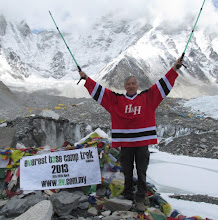 Day 10 Ollantaytambo to Inca Trail
Day 10 Ollantaytambo to Inca TrailThis is the day that we have been looking forward to for weeks if not months or years. After an early breakfast we packed up and board our bus for the Inca Trail trek. Our tour guide, Paula, could not stay with us on the trail because every spot had been taken; our local guide, Marcelino, along with Jaco, a chef, an assistant chef and 21 porters would take us to Machu Picchu. We started out on a paved road and after a few km veered left onto a dirt road. At the veer off point we saw a road block where the guards were checking cars for coca. Apparently coca is grown on the eastern slopes of the Andes and its transport westward is supposedly prevented by road blocks on the trans-Andean roads. Nevertheless, coca leaves are served everywhere- in the hotels at the self-serve hot drink stations near the front desk, in restaurants and at all meals on the Inca Trail. It’s treated as just another one of the herbal teas; it’s reputed to be a stimulant that is best not ingested before bedtime but no one in our tour group reported any feeling of stimulation.
Not long after, we arrived at km 82, Piskacuchu, to start our trek. This involved getting our trail passes, and showing them plus our passports to the control gate, followed by the usual group photograph under the trail sign. The trail started by immediately crossing the Urubamba River, which was running high and muddy at this time of year; it’s the end of the rainy season and the land is moist and the vegetation lush. The trail climbs gently along the left side of the river through really mixed vegetation; along with various trees, shrubs and grasses were quite a lot of prickly pear cacti. They had plenty of pears, many of which appeared to be ripe. The elevation at Piskacuchu is 2650 m and the trail climbed gently to our first camp site at Wayllabamba, which is only 3000 m. Nevertheless, the altitude plus a respiratory problem but I developed in Lima a few days earlier and something I ate that stirred up my gastrointestinal tract all conspired to drain my energy. That night Dr. Mom suggested that I try taking the ciprofloxacin that I had brought to control my cough which had apparently gotten worse. To this I added our altitude drug, acetazolamide (aka Diamox). They worked because I started to feel better and got stronger overnight.
Our group. Guide- Marcelino, assistant guide- Jaco, and 16 of us tourists being-
the Norwegians- Steiner (undertaker) and his sons Kristean (teacher) & Oyvind (doctor), Roulf and his son Earik,
Tam (arbourist) and Elizabeth Australians on their honeymoon,
Astrid (Aussie) and Peter both engineers from England,
Cecilia a Swede who commutes to Denmark to work at a big pharma,
Fletch (Gavin) and Dean (accountant) from South Africa,
Hanna (lawyer) and Jason (teacher) from England.
That afternoon K, O, E, P, F & D made up a team and played soccer against in a seemingly random grouping of guides and local teams. They played amazingly well especially considering the way that I felt. They played and lost 2 games by one goal after leading early in the games; you could see their energy level drop about half to a third of the way through because of the altitude. I was puffing just walking over to the small sandy soccer field.
On our arrival at camp, we were given juice to drink, and then asked to select our tent, from the many that the porters had already set up. The porters had all our tents set up on our arrival at camp and all we had to do was pick a tent for the rest of our trek. Most other people had rented sleeping bags and thicker sleeping pads from Gap; our tent had regular full length closed cell foam sleeping pads, and we used our own summer weight bags. Sleeping was quite comfortable although we tended to slide toward the door due to a gentle slope of the ground beneath. The campsites are located on terraces build during the Inca Empire. We were brought warm water in blue plastic basins with biodegradable soap and paper towels. When we closed the fly, we could wash quite well. At this point we knew that we would end the hike on the dirty side but nearly as smelly as we had imagined. We were given lunch soon after arrival, and then had snack at 5. Dinner (6:30) that night was trout plus vegetables and starch; a big part of the Peruvian mountain diet is rice and potatoes. There was some form of dessert after every dinner. The food overall was excellent especially when you consider that it was prepared under camping conditions. We took our meals in a tent that accommodated all of us, including M & J, along a central table sitting on plastic stools.



No comments:
Post a Comment